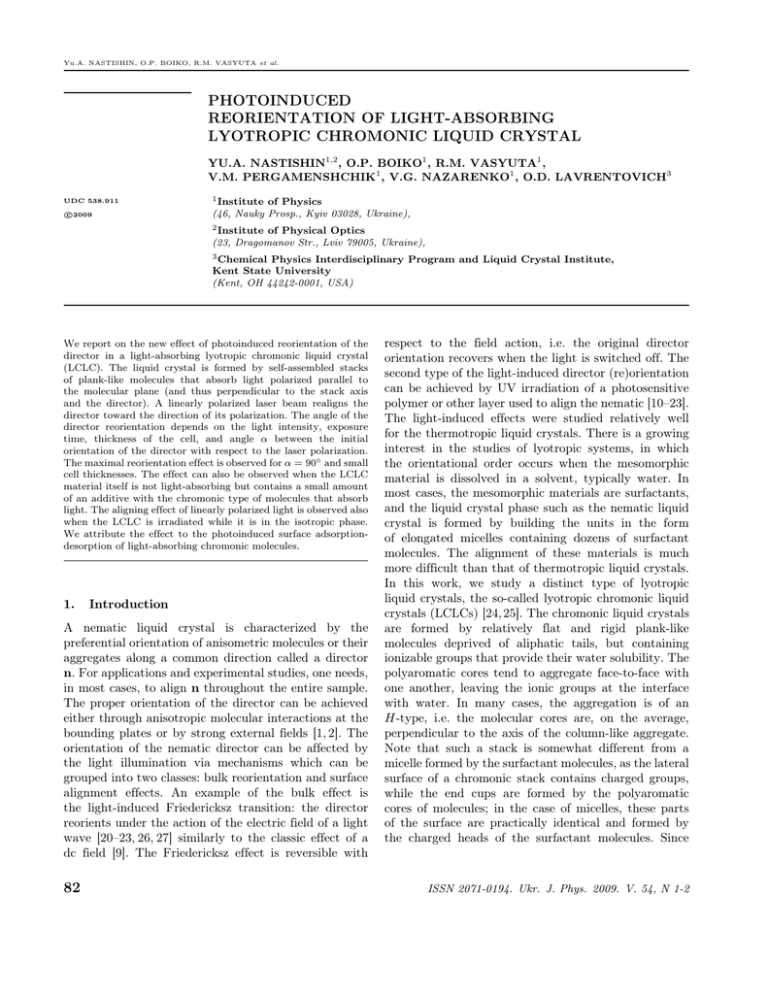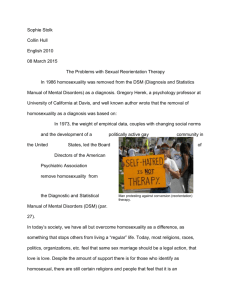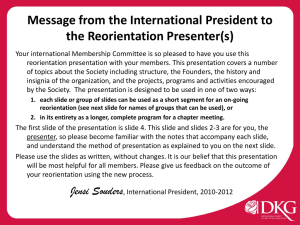PHOTOINDUCED REORIENTATION OF LIGHT-ABSORBING LYOTROPIC CHROMONIC LIQUID CRYSTAL YU.A. NASTISHIN
advertisement

Yu.A. NASTISHIN, O.P. BOIKO, R.M. VASYUTA et al. PHOTOINDUCED REORIENTATION OF LIGHT-ABSORBING LYOTROPIC CHROMONIC LIQUID CRYSTAL YU.A. NASTISHIN1,2 , O.P. BOIKO1 , R.M. VASYUTA1 , V.M. PERGAMENSHCHIK1 , V.G. NAZARENKO1 , O.D. LAVRENTOVICH3 UDC 538.911 c 2009 1 Institute of Physics (46, Nauky Prosp., Kyiv 03028, Ukraine), 2 Institute of Physical Optics (23, Dragomanov Str., Lviv 79005, Ukraine), 3 Chemical Physics Interdisciplinary Program and Liquid Crystal Institute, Kent State University (Kent, OH 44242-0001, USA) We report on the new effect of photoinduced reorientation of the director in a light-absorbing lyotropic chromonic liquid crystal (LCLC). The liquid crystal is formed by self-assembled stacks of plank-like molecules that absorb light polarized parallel to the molecular plane (and thus perpendicular to the stack axis and the director). A linearly polarized laser beam realigns the director toward the direction of its polarization. The angle of the director reorientation depends on the light intensity, exposure time, thickness of the cell, and angle α between the initial orientation of the director with respect to the laser polarization. The maximal reorientation effect is observed for α = 90◦ and small cell thicknesses. The effect can also be observed when the LCLC material itself is not light-absorbing but contains a small amount of an additive with the chromonic type of molecules that absorb light. The aligning effect of linearly polarized light is observed also when the LCLC is irradiated while it is in the isotropic phase. We attribute the effect to the photoinduced surface adsorptiondesorption of light-absorbing chromonic molecules. 1. Introduction A nematic liquid crystal is characterized by the preferential orientation of anisometric molecules or their aggregates along a common direction called a director n. For applications and experimental studies, one needs, in most cases, to align n throughout the entire sample. The proper orientation of the director can be achieved either through anisotropic molecular interactions at the bounding plates or by strong external fields [1, 2]. The orientation of the nematic director can be affected by the light illumination via mechanisms which can be grouped into two classes: bulk reorientation and surface alignment effects. An example of the bulk effect is the light-induced Friedericksz transition: the director reorients under the action of the electric field of a light wave [20–23, 26, 27] similarly to the classic effect of a dc field [9]. The Friedericksz effect is reversible with 82 respect to the field action, i.e. the original director orientation recovers when the light is switched off. The second type of the light-induced director (re)orientation can be achieved by UV irradiation of a photosensitive polymer or other layer used to align the nematic [10–23]. The light-induced effects were studied relatively well for the thermotropic liquid crystals. There is a growing interest in the studies of lyotropic systems, in which the orientational order occurs when the mesomorphic material is dissolved in a solvent, typically water. In most cases, the mesomorphic materials are surfactants, and the liquid crystal phase such as the nematic liquid crystal is formed by building the units in the form of elongated micelles containing dozens of surfactant molecules. The alignment of these materials is much more difficult than that of thermotropic liquid crystals. In this work, we study a distinct type of lyotropic liquid crystals, the so-called lyotropic chromonic liquid crystals (LCLCs) [24, 25]. The chromonic liquid crystals are formed by relatively flat and rigid plank-like molecules deprived of aliphatic tails, but containing ionizable groups that provide their water solubility. The polyaromatic cores tend to aggregate face-to-face with one another, leaving the ionic groups at the interface with water. In many cases, the aggregation is of an H-type, i.e. the molecular cores are, on the average, perpendicular to the axis of the column-like aggregate. Note that such a stack is somewhat different from a micelle formed by the surfactant molecules, as the lateral surface of a chromonic stack contains charged groups, while the end cups are formed by the polyaromatic cores of molecules; in the case of micelles, these parts of the surface are practically identical and formed by the charged heads of the surfactant molecules. Since ISSN 2071-0194. Ukr. J. Phys. 2009. V. 54, N 1-2 PHOTOINDUCED REORIENTATION OF LYOTROPIC CHROMONIC many chromonic materials are dyes (because of their polyaromatic molecular structure), one would expect that they should exhibit a variety of light-induced phenomena. However, till now, only one effect has been reported. Ichimura’s group demonstrated that one can achieve a uniform orientation of a chromonic liquid crystal by using a polymeric substrate doped with photosensitive azobenzene units [26, 27]. Note that the effect of light on the chromonic material is not direct, as it is achieved by a photomodification of the nonchromonic component in the substrate. In this work, we report on the effect of light on the director alignment in LCLCs. We demonstrate that the director can be reoriented by linearly polarized low-power laser beam. We attribute this effect to the photoinduced surface adsorption and desorption of light-absorbing chromonic molecules. 2. Materials and Sample Preparation We studied a water soluble LCLC forming material that is a derivative of indanthrone (6,15-disulfonicacid-7,16dichloro-indanthrone diammonium salt) called Blue 27, Fig. 1,a. The material was obtained from Optiva, Inc., San Francisco, CA. Individual molecules have a plank-like shape and assemble into aggregates that form the nematic (N) phase at room temperature at concentrations above 4.5wt%. Each Blue 27 molecule contains two easily ionizable groups, so that the electric charge per molecule is −2e, where e is the elementary charge. The phase diagram of an aqueous solution of Blue 27 [28] features a relatively wide biphasic region of the coexisting N and I phases. The light absorption in aligned samples of N material is anisotropic with the maximum absorption for light polarized perpendicularly to the rubbing direction of the aligning layers, which is consistent with the H aggregation, since the absorption direction is in the plane of the molecule, Fig. 1. Studies of molecular monolayers of Blue 27 [32] assembled by the electrostatic layer-by-layer deposition technique also demonstrate that the absorption axis is perpendicular to the shear direction during the deposition [33]. Note, however, that the geometry of aggregates bounded by a charged substrate might be generally different from the geometry of aggregates in the bulk [34]. The experiments were done on aligned samples for an aqueous solution of Blue 27. In this work, we used spin-coated and buffed films of polyimide SE-7511 (Nissan Chemical Industries, Ltd.) to align the N phase of LCLCs in planar fashion, along a single direction in the plane of the bounding substrate determined by the direction of buffing. Glass ISSN 2071-0194. Ukr. J. Phys. 2009. V. 54, N 1-2 Fig. 1. (a) Absorption spectra for a 4.5 wt. % Blue 27 water solution. Absorption coefficient k corresponds to n P (P is the direction of the incident light polarization), whereas k⊥ corresponds to n ⊥ P. Insert: Chemical structure of a Blue 27 molecule. (b) Schematical representation of the experimental observation of the light-induced director reorientation. Linearly polarized (P) laser beam cause the reorientation of the LCLC director n0 from the initial state n0 imposed by the substrate treatment (in our case, it is rubbing) to a new state n substrates were washed in an ultrasonic bath of Alconox detergent and water for 10 min at 60 ◦ C, removed, and dried. The polyimide SE-7511 Sunever, grade 7511L, and the solvent Sunever, both from Nissan Chemical Industries, Ltd. (Japan) were mixed in the proportion 1:1. The solution was coated onto the glass substrates by a spincoater at 1500 rpm. The coating was dried at 100 ◦ C for 2 min and then baked at 180 ◦ C for 1 h. The polyimid-coated substrates were rubbed using an aluminum block covered with felt. The cells were assembled from pairs of substrates with rubbing directions being antiparallel to each other. The thickness of the gap between the glass plates in LCLC cells was measured by the interference technique prior to the filling. The cells were filled at a temperature about 10 ◦ C above the clearing point by a capillary flow assisted by the negative pressure, and then promptly sealed. The 83 Yu.A. NASTISHIN, O.P. BOIKO, R.M. VASYUTA et al. flow direction and the pressure gradient were parallel to the buffing direction of the polyimide layers. The samples were also heated to about 10 ◦ C above the isotropic transition prior to each measurement, to mitigate the prehistory effects mentioned in [28]. The measurements were performed in 24 h after cooling to the N phase. 3. Experiments A modification of the nematic textures shown in Fig. 2 was observed during the irradiation of the oriented planar cell of the thickness 15 μm for 20 min by a He-Ne laser (λ = 633 nm, I = 3 W/cm2 ) with the light polarization oriented at the angle α = 45◦ with respect to the director. The fact that the spot is clearly visible implies that the orientation of the director within the spot is different from that outside the spot, where director remains parallel to the rubbing direction. For the light-absorbing LCLC, the director orientation is easy to determine by observing the cell on a microscope in the polarized light without an analyzer. For Blue 27, the maximum light absorption corresponds to the light polarization perpendicular to the director. Rotating the sample around the microscope axis, one can find that the director is not uniform within the spot. The deviation angle γ of the director from the rubbing direction smoothly increases from zero on the periphery of the spot to a maximal value γm at its center. The dark field in the upper photo corresponds to the original orientation of the director. Rotating the sample, one can see that the outside area demonstrates the increasing brightness, while a dark ring shrinks continuously from the periphery of the illuminated area to its center. The center of the illuminated area becomes extinguished, when the sample is rotated by α = 23◦ , indicating that γm = 23◦ . 4. Fig. 2. Microscopic pictures of a bright spot that appears after the irradiation of the B27 sample with the He-Ne laser light (λ = 633 nm, 20 min) polarized at 45◦ with respect to the rubbing direction. Condition of the observation: a) angle between the rubbing direction and the analyzer is equal to 0◦ , b) 10◦ , c) 33◦ . d) schematical representation of the director distribution within the sample 84 Results and Discussions To set the investigations on the quantitative basis, we have recorded how the cell transmission changes with the duration of illumination with the linearly polarized light. The measurements were performed without an analyzer. The sign of the transmittance change should indicate the direction of the director rotation. For example, an increase of the transmittance should indicate that the director reorients toward the direction of light polarization. Figure 3,a shows that the transmittance T (the ratio of the actual light intensity passed through ISSN 2071-0194. Ukr. J. Phys. 2009. V. 54, N 1-2 PHOTOINDUCED REORIENTATION OF LYOTROPIC CHROMONIC the sample to the incident intensity) increases with time, revealing a continuous director reorientation (Fig. 2,b) toward the light polarization direction. When the incident light polarization is parallel to the director, the transmittance changes very little. When the two are mutually perpendicular, α = 90◦ , the effect of director reorientation is maximum, Fig. 3,a,b. We measured the maximum angle γm , by which the director deviates from its original state at the center of the spot, where the light intensity is maximum, as a function of the angle α. The sample was irradiated with light of the intensity I = 3 W/cm2 during 40 min. For α = 0, we find γm = 0, although the results shown in Fig. 3,a display a slight increase of the transmittance. On the polarization microscope, one observes that the extinction of the irradiated spot is somewhat higher than that in the non-irradiated outside region, implying that, for α = 0, the light irradiation improves the uniform alignment of the director. For α ≥ 0, the maximal deviation γm increases with α, but saturates approximately at γm = 30◦ for large α. The fact that the maximal deviation γm is less than α can be attributed to the light absorption and to the anchoring effects combined with the elastic response of the director. The intensity of light propagating through the sample decreases. As a result, the reorientation on the second substrate can be smaller than that on the first one. Then the measured γm corresponds to the average reorientation angle. If this is true, then one can expect that the reorientation will be more efficient for thinner cells. To verify the possible dependence γm (d) on the cell thickness d, we have prepared a wedge-type cell with d = 25 μm at its thickest end and recorded the time evolution of the transmittance at spots with different local values of d. The dependence γm (d) for α = 60◦ , Fig. 4,a, shows that γm is larger for smaller d, supporting the idea that the reorientation effect is related to the light absorption. Note that the thick and thin parts of the wedge have different post-illumination behaviors. In thick spots (15 μm and thicker), the director reorients back toward the original surface orientation set by rubbing, within a relatively short time (the same as irradiation). In thin parts (9 μm and thinner), the relaxation is much slower. For d = 4 μm, the spot does not disappear at all. Even after the sample is heated into the isotropic phase for 1 h and then cooled back, the spot with a lightinduced director reorientation appears again. To explore the underlying mechanism of director reorientation, we performed another experiment, illuminating the material in the isotropic phase at a temperature higher than the clearing point. The cell was placed into a Microscope ISSN 2071-0194. Ukr. J. Phys. 2009. V. 54, N 1-2 Fig. 3. Response of a chromonic liquid crystal Blue 27 cell to the laser illumination (I = 3 W/cm2 , λ = 633 nm): a) in situ change of the cell transmittance during the illumination for different angles α between the director and the light polarization in the range 0 − 90◦ ; b) the same at α = 90◦ ; c) maximal reorientation angle γm after 40 min of the irradiation as a function of the angle α HotStage (HS1 precision hot stage, Instec, Inc.) and examined in the nematic phase at room temperature on the polarization microscope before the heating and illumination. After 1 h of illumination in the I phase, the cell was slowly cooled to the N phase. The light-induced director reorientation was clearly visible as a spot with a different director orientation in the illuminated region. Because the director orientation has been induced by the light illumination in the isotropic phase, one can exclude 85 Yu.A. NASTISHIN, O.P. BOIKO, R.M. VASYUTA et al. Fig. 5. a) Effective saturation time as a function of the illuminating light intensity determined from the data shown in Fig. 4,a by the double tangent procedure as illustrated in Fig. 4,a, b) In situ measured time evolution of the transmittance and its relaxation Fig. 4. a) Thickness dependence of the maximal reorientation angle γm for α = 60◦ . b) Time evolution of the cell transmittance for different intensities of the illuminating laser light in the range between 2.9 and 23.3 W/cm2 for α = 90◦ . c) Saturated transmittance T40 , and d) maximal reorientation angle γm measured at t = 40 min as a function of the illuminating light intensity I determined from the data shown in Fig. 4,b 86 the bulk reorientation effects [20–23, 26, 27] from the consideration and thus to conclude that the observed light-induced director reorientation is a result of the light-induced reorientation at the substrates. The time scales, on which the director reorientation dynamics saturates, depend on the angle α between the light polarization and the director: the saturation time increases with α. To characterize these time scales quantitatively, we introduce a parameter ts , which we call Effective Saturation Time (EST). The EST value is obtained as the coordinate, ts , of the point, where the two lines tangent to the dependence T (t) at small t and large t, cross each other. Figure 4,b demonstrates the time evolution of the transmittance for different values of the laser light intensity I (power per unit area, measured in W/cm2 ). The effect is larger for larger I (Fig. 4,b). Figure 4,c shows the value of the cell transmittance T40 , and Fig. 4,d presents the maximal reorientation angle γm with corresponding exposure time t = 40 min as a function of I for α = 90◦ . As it can be expected, ts decreases when I increases (Fig. 5,a). The ts value is smaller for smaller α. Figure 5,b shows the dynamics of the reorientation effect for a 15 μm-thick ISSN 2071-0194. Ukr. J. Phys. 2009. V. 54, N 1-2 PHOTOINDUCED REORIENTATION OF LYOTROPIC CHROMONIC sample irradiated at α = 25◦ by a polarized light of the intensity I = 11.6 W/cm2 at room temperature. The time needed to relax the director to its original state after the light is switched off is about 2000 sec, longer than the time of approximately 500 s needed to reorient the director by switching the light on. The time needed for the total relaxation is on the scale of hours. Large values of the relaxation time agree with the idea that the light-induced director reorientation is related to the anisotropic adsorptiondesorption of dye molecules at the substrates [23]. The adsorption-desorption process, that depends on the angle between the absorbing plane of chromonic molecules and the light polarization, should increase the population of molecules aligned perpendicularly to the light polarization. This is followed by the collective response of neighboring LCLC aggregates, which results in the observed director reorientation. This mechanism is also supported by experiments with a non-absorbing LCLC material disodium cromoglycate (DSCG). We used 15-μm-thick cells filled with nematic phases formed by pure DSCG 15 wt. % in water and DSCG doped with a light-absorbing chromonic material Red 2416 at a very small concentration of 0.0024 wt. %. The cell was illuminated by the laser light (λ = 496 nm) with the polarization of the illuminating light perpendicular to the rubbing direction. For this wavelength, the chromolyne material is transparent [35], while Red 2416 demonstrates the maximum absorption at λ = 480 nm [36]. For the cells filled with pure DSCG, we observed no director reorientation, but we did find this effect when the cell was dopped by Red 2416, Fig. 6. The inner area (realigned domain) separated by a wall defect from the outer domain (with original alignment) is seen in the place of the irradiating spot. The sample was observed between crossed polarizers as depicted in Fig. 6. 5. Conclusion Fig. 6. Texture of a cell with chromolyn doped by dye Red 2416 (0.0024 wt. %) after the illumination by the laser light (λ = 496 nm, 20 min) with the polarization perpendicular to the rubbing direction. Conditions of the observation: crossed polarizers, red λplate, the cell is rotated cw. by 45◦ with respect to an analyzer. The inner area limited by the wall defect appears in the place of the laser spot The work was supported by National Science Foundation, Grant DMR-076290, Fundamental Researches State Fund, Grant UU24/018, and National Academy of Science of Ukraine, Grant #1.4.1B/109. 1. M. Kleman and O.D. Lavrentovich, Soft Matter Physics: An Introduction (Springer, New York, 2003). 2. Th. Rasing and I. Musevic, Surfaces and interfaces of Liquid Crystals (Springer, New York, 2004). 3. A.S. Zolot’ko, V.F. Kitaeva, N. Kroo, N.I. Sobolev, and L. Csillag, Sov. Phys. JETP Lett. 32, 158 (1980). 4. Ya. Zel’dovich, N.F. Pilipetskii, A.V. Sukhov, and N.V. Tabiryan, Sov. Phys. JETP Lett. 31, 263 (1980). 5. I. Jánossy, A.D. Lloyd, and B.S. Wherrett, Mol. Cryst. Liq. Cryst. 179, 1 (1990). 6. L. Marrucci, Liquid Crystal Today 11, No. 3, 1 (2002). 7. V.M. Pergamenshchik, V.Ya. Gayvoronskiy, S.V. Yakunin, R.M. Vasyuta, V.G. Nazarenko, and O.D. Lavrentovich, Mol. Cryst. Liq. Cryst. 454, 145 (2006). 8. V.Ya. Gayvoronskiy, S.V. Yakunin, V.M. Pergamenshchik, and V.G. Nazarenko, Laser Phys. Lett. 3, 531 (2006). 9. P.G. de Gennes and J. Prost, The Physics of Liquid Crystals (Oxford, Clarendon Press, 1993). 10. K. Ichimura, Chem. Rev. 100, 1847 (2000). We have observed, for the first time, the light-induced director realignment in a Lyotropic Chromonic Liquid Crystal and proposed that the effect is caused by the anisotropic adsorption-desorption of light-absorbing LCLC molecules at the surfaces of substrates. Further studies of this effect can be performed by analyzing the absorbed layers of LCLC molecules directly, for example, by the atomic force microscopy or by the X-ray microscopy described in [37]. ISSN 2071-0194. Ukr. J. Phys. 2009. V. 54, N 1-2 11. M. O’Neill and S.M. Kelly, J. Phys. D: Appl. Phys. 33, R67 (2000). 12. M. Schadt, K Schmitt, V. Kozinkov, and V. Chigrinov, Japan J. Appl. Phys. 31, 2135 (1992). 13. J.-H. Kim, S. Kumar, and S.-D. Lee, Phys. Rev. E 57, 5644 (1998). 14. S.W. Lee et al., Macromolecules 36, 6527 (2003). 15. A. Dyadyusha et al., Ukr. Fiz. Zh. 36, 1059 (1991). 16. V.P. Vorflusev, H.-S. Kitzerow, and V.G. Chigrinov, Appl. Phys. A 64, 615 (1997). 87 Yu.A. NASTISHIN, O.P. BOIKO, R.M. VASYUTA et al. 17. S. Dante et al., Langmuir 15, 193 (1999). 18. L.T. Thieghi et al., Phys. Rev. E 67, 041701 (2003). 19. E. Ouskova, D. Fedorenko, Yu. Reznikov, S.V. Shiyanovskii, L. Su, J.L. West, O.V. Kuksenok, O. Francescangeli, and F. Simoni, Phys. Rev. E 64, 021701 (2001). 20. O. Francescangeli, L. Lucchetti, F. Simon, V. Stanic, and A. Mazulla, Phys. Rev. E 71, 011702 (2005). 21. Yu. Reznikov et al., Phys. Rev. Lett. 84, 1930 (2000). 22. S. Kumar, J.-H. Kim, and Y. Shi, Phys. Rev. Lett. 94, 077803 (2005). 23. V.G. Nazarenko, O.P. Boiko, A.B. Nych, Yu.A. Nastishin, V.M. Pergamenshchik, and P. Bos, Europhys. Lett. 75, 448 (2006). 24. A.S. Vasilevskaya, E.V. Generalova, A.S. Sonin, Russ. Chem. Rev. 58, 904 (1989). 25. J.E. Lydon, in Handbook of Liquid Crystals 2B, edited by D. Demus, J. Goodby, G.W. Gray, H.-W. Speiss, and V. Vill (Wiley-VCH, Weinheim, 1998), p. 981. 26. T. Fujiwara and K. Ichimura, J. Mater. Chem. 12, 3387 (2002). 27. K. Ichimura, T. Fujiwara, M. Momose, and D. Matsunaga, J. Mater. Chem. 12, 3380 (2002). 28. Yu.A. Nastishin, H. Liu, T. Schneide, V. Nazarenko, R. Vasyuta, S.V. Shiyanovskii, and O.D. Lavrentovich, Phys. Rev. E 72, 041711 (2005). 29. T.J. Sluckin, Liq. Cryst. 6, 111 (1989). 30. P.A. Buining and H.N.W. Lekkerkerker, J. Phys. Chem. 97, 11510 (1993). 31. R.M.L. Evans, Phys. Rev. E 59, 3192 (1999). 32. T. Schneider and O.D. Lavrentovich, Langmuir 16, 5227 (2000). 33. O.P. Boiko, R.M. Vasyuta, V.G. Nazarenko, V.M. Pergamenshchik, Yu.A. Nastishin, and O.D. Lavrentovich, Mol. Cryst. Liq. Cryst. 467, 181 (2007). 88 34. T. Schneider, K. Artyushkova, J.E. Fulghum, L. Broadwater, A. Smith, and O.D. Lavrentovich, Langmuir 21, 2300 (2005). 35. R. Vasyuta, O. Boiko, Yu. Piryatinskiy, A. Kachkovskiy, and V. Nazarenko, Mol. Cryst. Liq. Cryst. 426, 117 (2005). 36. O. Boiko, O. Komarov, R. Vasyuta, V. Nazarenko, Yu. Slominskiy, and T. Schneider, Mol. Cryst. Liq. Cryst. 434, 305 (2005). 37. K.V. Kaznatcheev, P. Dudin, O.D. Lavrentovich, A.P. Hitchcock, Phys. Rev. E 76, 061703 (2007). ФОТОIНДУКОВАНА ПЕРЕОРIЄНТАЦIЯ СВIТЛОПОГЛИНАЮЧОГО ЛIОТРОПНОГО ХРОМОНIЧНОГО РIДКОГО КРИСТАЛА Ю.А. Настишин, О.П. Бойко, Р.М. Васюта, В.М. Пергаменщик, В.Г. Назаренко,О.Д. Лаврентович Резюме В данiй роботi описано новий ефект фотоiндукованої переорiєнтацiї в свiтлопоглинаючому лiотропному хромонiчному рiдкому кристалi (ЛХРК). Такi рiдкi кристали утворюються самоорганiзованими колонками плоских молекул, що поглинають свiтло поляризоване паралельно площинi молекули (тобто перпендикулярно до вiсi колонки та директора). Лiнiйно поляризоване лазерне випромiнювання переорiєнтовує директор вздовж поляризацiї променя. Кут переорiєнтацiї залежить вiд iнтенсивностi свiтла, часу експозицiї, товщини комiрки, та початкової орiєнтацiї директора по вiдношенню до поляризацiї променя. Максимальний ефект переорiєнтацiї спостерiгався для α = 90◦ i малих товщин комiрки. Ефект також може спостерiгатись для непоглинаючих ЛХРК, що мiстять малу кiлькiсть свiтлопоглинаючих домiшок молекул хромонiчного типу. Переорiєнтацiя ЛХРК також спостерiгається при опромiнюваннi в iзотропному станi. Ми пов’язуємо ефект з поверхневою фотоiндукованою адсорбцiєю-десорбцiєю свiтлопоглинаючих хромонiчних молекул. ISSN 2071-0194. Ukr. J. Phys. 2009. V. 54, N 1-2




